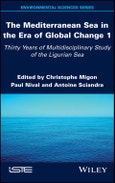Due to its particular characteristics, the Mediterranean Sea is often viewed as a microcosm of the World Ocean. Its proportionally-reduced dimensions and peculiar hydrological circulation render it susceptible to environmental and climatic constraints, which are rapidly evolving. The Mediterranean is therefore an ideal site to examine, in order to better understand a number of key oceanographic phenomena. This is especially true of the Ligurian Sea where, due to its geology, oceanic conditions are found close to the coast.
As such, 30 years ago, an offshore time-series site provided a fresh impetus to a long history of marine biology research, which has generated a very important body of data and knowledge. This is the first volume, in a two-volume series, that summarizes this research. Across these two books, the reader will find 13 chapters that examine the geology, physics, chemistry and biology of the Ligurian Sea ? always with the goal of providing key elements of oceanography in a changing world.
Table of Contents
Preface ix
Chapter 1. The Development of Knowledge of the Ligurian Sea 1
Paul NIVAL
1.1. The first naturalists on the shores of the Ligurian Sea 1
1.2. Vertical structure of the Mediterranean and hydrodynamics 4
1.3. Flow rate of the Ligurian Current 8
1.4. Mesoscale structures in the Ligurian Sea: hydrodynamic front and the search for spatial precision 9
1.5. The seabed and living species 11
1.6. Study of chemical substances in the Ligurian Sea 12
1.7. Towards a synoptic vision of the Ligurian Sea.Remote sensing 13
1.8. Towards continuous observation and environmental monitoring 15
1.9. References 16
Chapter 2. The Ligurian Basin: A Geomorphologic and Geological Background 27
Jean MASCLE, Sébastien MIGEON and Virginie HASSOUN
2.1. Introduction 27
2.2. Geographic and geological boundaries 27
2.3. Origin and geological evolution of the Ligurian basin and of its margins: a brief review 29
2.3.1. Birth of the Ligurian basin 29
2.3.2. Creation and evolution of the Ligurian Sea continental margins 32
2.4. Morphology of the Ligurian Sea 35
2.4.1. General morphology 35
2.4.2. Submarine canyons 37
2.5. Sedimentary cover and sedimentary processes 38
2.5.1. Evolution of the sedimentary cover 38
2.5.2. Prevailing sedimentary mechanisms 41
2.6. A few concluding remarks 45
2.7. References 47
Chapter 3. Physical Oceanography of the Ligurian Sea 49
Louis PRIEUR, Fabrizio D’ORTENZIO, Vincent TAILLANDIER and Pierre TESTOR
3.1. Introduction 49
3.2. Circulation patterns from large scale to frontal dynamics 50
3.3. Observation time series: sentinel of the Mediterranean Sea 64
3.4. Discussion and conclusion 72
3.5. References 74
Chapter 4. The Carbonate System in the Ligurian Sea 79
Laurent COPPOLA, Jacqueline BOUTIN, Jean-Pierre GATTUSO, Dominique LEFEVRE and Nicolas METZL
4.1. Introduction 79
4.2. Distribution of the carbonate system in the Ligurian Sea 83
4.3. The seasonal cycle in surface water 85
4.4. Long-term changes in the carbonate system and acidification 89
4.4.1. Surface trends 89
4.4.2. Interior trends 92
4.5. Changes in the carbonate system in the Ligurian Sea in the Mediterranean Sea and global contexts 95
4.6. Conclusion 97
4.7. Acknowledgments 97
4.8. References 98
Chapter 5. Emission Sources, Fluxes and Spatiotemporal Distribution of Nutritive Resources 105
Christophe MIGON, Orens PASQUERON DE FOMMERVAULT and Fayçal KESSOURI
5.1. Introduction 105
5.2. What is required for biological development? 106
5.3. Sources of nutrients 110
5.3.1. External sources 110
5.3.2. Inputs from deep layers 117
5.3.3. Budgets 118
5.4. Seasonal patterns 119
5.5. Spatial distribution 121
5.6. Chemical limitation of primary production 122
5.6.1. The Redfield model 122
5.6.2. Peculiarity of N:P molar ratios in the Ligurian area 123
5.6.3. Model of P-limitation 125
5.7. Decadal trends and possible consequences for regional productivity 127
5.8. Concluding remarks 129
5.9. References 129
Chapter 6. Primary Production in the Ligurian Sea 139
Nicolas MAYOT, Paul NIVAL and Marina LEVY
6.1. Annual cycle of phytoplankton biomass, production and community structure in the Ligurian Sea 139
6.1.1. Regional context of the area 139
6.1.2. The diversity of phytoplankton species: the base of community ecology 142
6.1.3. Phytoplankton community structure 146
6.2. From the influence of small spatiotemporal features to the interannual and long-term variability 150
6.3. Modeling the impact of the physics on phytoplankton growth and distribution 152
6.4. References 154
Chapter 7. Pelagic Viruses, Bacteria and Archaea 165
Markus WEINBAUER and Branko VELIMIROV
7.1. Background 165
7.1.1. Microbial food webs 166
7.1.2. Microbe-mediated ecosystem functions and biogeochemical cycles 167
7.2. Study sites 168
7.3. Diel variability of micro-organisms 168
7.4. Seasonal variability of micro-organisms 170
7.5. Variability of micro-organisms: sunlight versus dark ocean 172
7.6. Effect of episodic events on micro-organisms: upwelling and aerosols 174
7.6.1. Upwelling 174
7.6.2. Sahara dust aerosols 175
7.6.3. Volcano ash aerosols 177
7.6.4. Black carbon-rich aerosols 178
7.6.5. Conclusions 179
7.7. Effect of turbulence on micro-organisms 180
7.8. Effect of global warming and ocean acidification on micro-organisms 180
7.9. Effect of P-limitation on micro-organisms 181
7.10. Effect of viral lysis and flagellate grazing on prokaryotic diversity and growth 182
7.11. Nanobacteria, ultramicrobacteria and starvation forms 184
7.12. Microbial diversity hypothesis 185
7.13. Horizontal gene transfer 185
7.14. Acknowledgments 186
7.15. References 186
Acronyms 193
Glossary 197
List of Authors 215
Index 217
Summary of Volume 2 219








